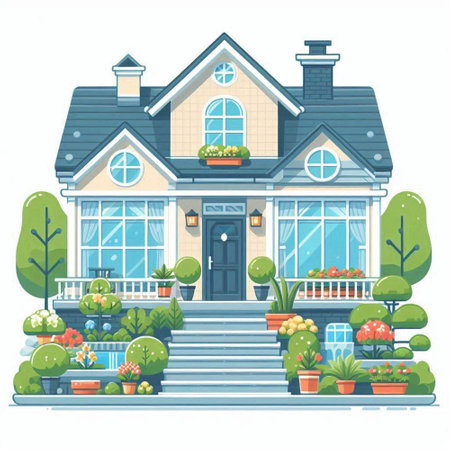1. Understanding Your Climate Zone
Before you start planting a four-season garden, it’s essential to understand your local climate. Knowing which plants will thrive in your area year-round starts with identifying your USDA Hardiness Zone and recognizing any regional microclimates that may affect plant health and appearance throughout the seasons.
What Are USDA Hardiness Zones?
The United States Department of Agriculture (USDA) created a system that divides the country into 13 zones based on average annual minimum winter temperatures. Each zone is further divided into “a” and “b” subzones. This helps gardeners choose plants that can survive local winters. For example, if you live in Zone 7a, you should look for plants labeled as hardy to at least 0°F (-17.8°C).
USDA Hardiness Zones Overview
| Zone | Average Minimum Temperature (°F) | Suitable Plant Types |
|---|---|---|
| 3 | -40 to -30 | Cold-hardy perennials, evergreens |
| 5 | -20 to -10 | Drought-tolerant shrubs, conifers |
| 7 | 0 to 10 | Flowering trees, bulbs, deciduous shrubs |
| 9 | 20 to 30 | Tropical plants, citrus trees, succulents |
| 11+ | Above 40 | Palm trees, orchids, exotic flowers |
The Role of Microclimates
A microclimate is a small area within your yard or neighborhood that has slightly different conditions than the surrounding region. It could be warmer, cooler, wetter, or windier depending on factors like elevation, shade from buildings or trees, and proximity to bodies of water. These variations can influence which plants will grow successfully in specific parts of your garden.
Common Microclimate Factors
- Slope and Elevation: South-facing slopes receive more sun and stay warmer.
- Shelter from Wind: Fences or walls can protect delicate plants from harsh winds.
- Paved Areas: Driveways and patios radiate heat, creating warmer pockets.
- Trees and Structures: Provide shade that cools areas during summer months.
Selecting Plants for Year-Round Appeal
Your goal is to create visual interest in all four seasons—spring blooms, summer color, autumn foliage, and winter texture. Choosing the right mix of evergreen shrubs, flowering perennials, and seasonal annuals adapted to your hardiness zone and microclimate is key.
A Few Tips:
- Select native species—theyre already adapted to your zone.
- Add evergreens for year-round structure.
- Use deciduous trees with striking fall colors.
- Add winter-interest plants like red twig dogwood or ornamental grasses.
This foundational understanding of climate zones and microclimates sets the stage for designing a vibrant garden that thrives through every season across any U.S. region.
Designing for Four Seasons
Creating a beautiful garden that thrives all year long means planning with all four seasons in mind. A well-designed four-season garden isnt just about choosing the right plants—its also about smart layout, layering, and placing focal points that keep your yard looking vibrant from January through December.
Plan Your Layout for Year-Round Interest
The foundation of a successful four-season garden starts with a thoughtful layout. Think about how your garden looks from different viewpoints—like your front porch, kitchen window, or driveway. Arrange paths, beds, and seating areas so that there’s always something eye-catching no matter the season. Use curved lines and varying bed shapes to create flow and natural movement throughout your space.
Key Layout Tips:
- Create structure: Use evergreen shrubs, ornamental grasses, or garden walls to define spaces that stay interesting even in winter.
- Layer heights: Place taller plants at the back or center (depending on your garden’s orientation) and shorter ones toward the front.
- Leave room to grow: Consider the mature size of each plant to avoid overcrowding and ensure seasonal displays aren’t hidden.
Use Focal Points for Visual Impact
A strong focal point draws the eye and adds personality to your garden. It can be anything from a small tree with striking bark in winter to a colorful bench or sculpture. These elements give your garden structure when flowers fade and leaves fall.
Focal Point Ideas by Season:
| Season | Focal Point Suggestions |
|---|---|
| Spring | Flowering trees like dogwood or redbud |
| Summer | Garden arbor with climbing roses or clematis |
| Fall | Sculpture surrounded by mums and ornamental grasses |
| Winter | Decorative urns, evergreen topiaries, or birch branches |
Layer Plants for Seasonal Transitions
Plant layering is key to keeping your garden looking full and colorful throughout the year. Mix different types of plants—trees, shrubs, perennials, and ground covers—to create depth and variety. Each layer should offer something unique across the seasons: blooms in spring, lush foliage in summer, fiery colors in fall, and texture or structure in winter.
Example of Plant Layering:
| Plant Layer | Seasonal Feature | Example Plants |
|---|---|---|
| Trees (Upper) | Spring blossoms, fall color, winter bark | Serviceberry, Japanese maple |
| Shrubs (Mid) | Scented flowers, berries, evergreen leaves | Hydrangea, boxwood, winterberry holly |
| Perennials (Lower) | Blooms from spring to fall | Black-eyed Susan, coneflower, hostas |
| Ground Covers (Base) | Covers soil year-round; some bloom seasonally | Creeping thyme, ajuga, sweet woodruff |
A little planning goes a long way when it comes to designing a garden that brings joy through every season. By combining thoughtful layout strategies with layered planting and intentional focal points, you’ll enjoy color and interest no matter what time of year it is.

3. Selecting Plants for Year-Round Color
When planning a four-season garden, choosing the right mix of plants is key to ensuring your outdoor space stays vibrant and interesting all year long. The goal is to combine annuals, perennials, trees, and shrubs that each shine in different seasons, while also offering lasting appeal through foliage color, plant texture, and overall form.
Understanding Plant Types
To build a dynamic garden that evolves beautifully with the seasons, its helpful to understand the basic types of plants youll be working with:
| Plant Type | Description | Seasonal Benefits |
|---|---|---|
| Annuals | Plants that complete their life cycle in one season. | Provide vibrant color in spring and summer; easy to swap out yearly. |
| Perennials | Return year after year with seasonal blooms. | Add structure and dependable color at specific times of the year. |
| Trees | Larger plants offering shade, structure, and seasonal interest. | Spring blossoms, fall foliage, winter silhouettes. |
| Shrubs | Medium-sized woody plants with multi-season features. | Berries in fall/winter, flowers in spring/summer, evergreen foliage. |
Seasonal Highlights by Plant Type
The secret to a well-balanced four-season garden is staggering bloom times and selecting plants with standout features beyond flowers. Heres how you can layer your garden for continuous appeal:
🌸 Spring
- Trees: Flowering dogwood, cherry blossom
- Shrubs: Forsythia, lilac
- Perennials: Tulips, daffodils
- Annuals: Pansies, snapdragons
☀️ Summer
- Trees: Crape myrtle, magnolia
- Shrubs: Hydrangea, butterfly bush
- Perennials: Coneflower, daylilies
- Annuals: Petunias, marigolds
🍂 Fall
- Trees: Maple (for brilliant foliage)
- Shrubs: Burning bush, viburnum (with berries)
- Perennials: Asters, sedum Autumn Joy
- Annuals: Mums, ornamental kale
❄️ Winter
- Trees: Birch (for bark texture), evergreens like pine or spruce
- Shrubs: Holly (with red berries), boxwood (evergreen)
- Perennials: Hellebores (also called Lenten rose)
- Annuals: In warmer regions—winter pansies or ornamental cabbage
Create Layers for Visual Interest
A great way to keep your garden visually appealing throughout the year is by designing it in layers. Use taller trees and shrubs as a backdrop or anchor points. Fill in mid-level areas with perennials and use low-growing groundcovers or annuals along edges or walkways. This layered approach helps create depth and keeps your garden looking full even during dormant seasons.
Select Plants with Multi-Season Appeal
If youre limited on space or want less maintenance, look for plants that offer more than one season of beauty. Here are some examples:
| Plant Name | Main Features | Seasons of Interest |
|---|---|---|
| Autumn Brilliance Serviceberry (Amelanchier) | Blooms in spring, edible berries in summer, red foliage in fall | Spring–Fall |
| Ninebark (Physocarpus opulifolius) | Bark peels for winter interest; colorful leaves; summer flowers | All year (especially Winter–Summer) |
| Purple Coneflower (Echinacea purpurea) | Blooms in summer; seed heads attract birds in fall/winter | Summer–Winter |
| Cotoneaster horizontalis | Cascading form; red berries; small flowers; fall leaf color | Spring–Winter |
A Regional Approach Matters Too!
Your local climate will influence which plants thrive best in your area. Consider USDA Hardiness Zones when selecting trees and shrubs. A plant perfect for New England may not do well in Arizonas heat. Visit local nurseries or extension offices for advice tailored to your region’s growing conditions.
Quick Tip:
If you’re just starting out or have limited time to maintain your garden, begin with perennials and shrubs that provide interest across multiple seasons. You can always add annuals later for quick pops of color!
4. Incorporating Hardscape and Decorative Elements
When planning a four-season garden, it’s easy to focus on flowers and foliage—but what happens when the blooms fade? That’s where hardscape and decorative elements come in. These features add structure, texture, and visual interest year-round, especially during the quieter seasons like winter or early spring.
Why Hardscape Matters
Hardscape refers to the non-living parts of your landscape design—things like pathways, patios, retaining walls, and pergolas. These elements create a strong foundation for your garden and guide movement through your outdoor space. In colder months, when plants may be dormant, well-designed hardscape keeps your garden looking attractive and inviting.
Common Hardscape Features
| Element | Description | Seasonal Benefits |
|---|---|---|
| Garden Paths | Paved or gravel walkways that connect different areas | Add structure and accessibility year-round |
| Pergolas & Arbors | Wood or metal structures that provide shade or support climbing plants | Create height and focal points even in winter |
| Retaining Walls | Masonry or stone walls used to manage slopes or define spaces | Add elevation changes and visual depth during off-seasons |
| Paver Patios | Sitting areas made from stone, brick, or concrete pavers | A functional area that remains usable year-round |
The Power of Decorative Elements
Sculptures, water features, and decorative containers can make your garden feel alive even without blooms. These items draw the eye and reflect your personal style while enhancing curb appeal in all seasons.
Sculpture and Art Pieces
A well-placed statue or garden ornament provides a focal point that doesn’t rely on seasonal change. Choose weather-resistant materials like metal, stone, or treated wood for durability across regions.
Water Features
A small pond, fountain, or birdbath adds sound and movement to your landscape. In warmer climates, these can run year-round; in colder areas, they still provide visual interest—even when frozen over!
Decorative Containers
Pots filled with evergreens or seasonal arrangements offer flexibility. You can swap out plants as the seasons change or use them as accent pieces near entryways or patios.
Tying It All Together
The key to using hardscape and decor effectively is balance. Too many elements can feel cluttered; too few might leave your garden feeling bare in off-peak months. Try mixing textures—like smooth stone paths with rustic wooden trellises—and repeat colors found in surrounding architecture to unify the look across all seasons.
A Quick Tip:
If you live in a region with heavy snowfall, choose hardscape materials that are easy to shovel or brush off so you can enjoy their beauty all winter long.
A thoughtful combination of structural elements and creative accents ensures that your garden stays visually appealing no matter the season.
5. Seasonal Maintenance and Care
To keep your four-season garden thriving throughout the year, its important to give it the right care at the right time. Each season brings unique needs for your plants, so staying on top of pruning, mulching, fertilizing, and general clean-up will help maintain a healthy and colorful landscape no matter where you live.
Pruning Tips by Season
Regular pruning encourages healthy growth and keeps plants looking their best. Heres a quick guide:
| Season | What to Prune | Why It Matters |
|---|---|---|
| Spring | Dead or damaged branches from winter, early-blooming shrubs after flowering | Promotes new growth and shapes plants |
| Summer | Shrubs that bloom in spring, spent flowers (deadheading) | Keeps garden tidy and may encourage re-blooming |
| Fall | Trees and shrubs needing shape, perennials after dieback | Prepares garden for winter rest |
| Winter | Dormant trees and shrubs, avoid heavy pruning in extreme cold | Makes structural changes easier without stressing the plant |
Mulching for Moisture and Protection
A good layer of mulch helps retain soil moisture, suppress weeds, and protect roots during temperature shifts. Use organic mulch like shredded bark or composted leaves. Apply 2–3 inches around plants but keep it a few inches away from stems to prevent rot.
Fertilizing by Plant Needs and Timing
Your gardens feeding schedule depends on plant type and regional climate. Generally:
- Spring: Fertilize most perennials, shrubs, and lawns to support new growth.
- Mid-Summer: Give vegetables and annuals a mid-season boost with balanced fertilizer.
- Fall: Avoid nitrogen-heavy fertilizers; instead use products that strengthen roots for winter.
Seasonal Clean-Up Checklist
A tidy garden is not just about looks—it prevents pests and diseases too. Here’s what to focus on each season:
| Season | Main Tasks |
|---|---|
| Spring | Remove dead leaves, trim back perennials, refresh mulch, clean tools |
| Summer | Pest check-ups, remove weeds regularly, water deeply in dry spells |
| Fall | Cull dead plants, rake leaves, divide crowded perennials, compost cleanup debris |
| Winter | Covers for sensitive plants if needed, monitor snow damage on branches |
A little attention each season goes a long way in keeping your four-season garden vibrant and full of life all year round.


